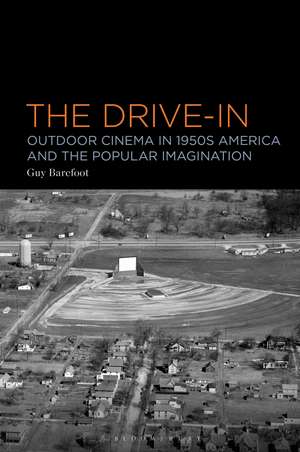The Drive-In: Outdoor Cinema in 1950s America and the Popular Imagination
Autor Dr Guy Barefooten Limba Engleză Hardback – 13 dec 2023
Preț: 540.15 lei
Preț vechi: 773.90 lei
-30% Nou
Puncte Express: 810
Preț estimativ în valută:
103.36€ • 112.62$ • 87.09£
103.36€ • 112.62$ • 87.09£
Carte tipărită la comandă
Livrare economică 24 aprilie-08 mai
Preluare comenzi: 021 569.72.76
Specificații
ISBN-13: 9781501365928
ISBN-10: 1501365924
Pagini: 272
Ilustrații: 14 bw illus
Dimensiuni: 152 x 229 mm
Greutate: 0.53 kg
Editura: Bloomsbury Publishing
Colecția Bloomsbury Academic
Locul publicării:New York, United States
ISBN-10: 1501365924
Pagini: 272
Ilustrații: 14 bw illus
Dimensiuni: 152 x 229 mm
Greutate: 0.53 kg
Editura: Bloomsbury Publishing
Colecția Bloomsbury Academic
Locul publicării:New York, United States
Caracteristici
Sets out the importance that the drive-in cinema has had as a post-war development in the consumption of entertainment and an image of 1950s America and youth culture
Notă biografică
Guy Barefoot is Honorary Visiting Fellow at the University of Leicester, UK, where he was Associate Professor in Film Studies until 2022. He is the author of the books Trash Cinema: The Lure of the Low (2017), The Lost Jungle: Cliffhanger Action and Hollywood Serials of the 1930s and 1940s (2017), and Gaslight Melodrama: From Victorian London to 1940s Hollywood (2001).
Cuprins
Acknowledgements List of Illustrations List of Tables Note to the Reader Introduction 1. Place 2. Programme 3. People 4. Pictures Conclusion: The Drive-In and Cinema History Endnotes Archives and Databases Consulted Select Bibliography
Recenzii
Guy Barefoot's The Drive-In is a crucial addition not only to scholarship on American film exhibition, but also to the entire field of Film Studies. Rigorously researched and accessibly written, the book will serve as the major work on drive-in theaters for many years to come.
The drive-in movie theatre occupies an iconic position in the history of American cinema. In this hugely engaging and informative account, Guy Barefoot goes beyond our popular conception of the drive-in to examine its history and its role in American cultural identity since the 1950s. This is an exceptional and much-needed addition to cinema scholarship, which combines a meticulously researched focus on locations, economics and audiences, with an exploration of the ways in which the popular meaning of the drive-in theatre has been constructed across the arts.
We've long known Guy Barefoot to be a fine historian of film and culture, but The Drive-In might be his best work yet. This is an engaging and rigorous example of scholarship, which explores the drive-in phenomenon in the US in the 1950s, addressing the geographic spread of outdoor cinemas, their owners, their diverse entertainment programmes, those who frequented them and their symbolism then and since. This is a fabulous book that deserves the attention of anyone interested in the cultural history of cinema and its institutions.
The drive-in movie theatre occupies an iconic position in the history of American cinema. In this hugely engaging and informative account, Guy Barefoot goes beyond our popular conception of the drive-in to examine its history and its role in American cultural identity since the 1950s. This is an exceptional and much-needed addition to cinema scholarship, which combines a meticulously researched focus on locations, economics and audiences, with an exploration of the ways in which the popular meaning of the drive-in theatre has been constructed across the arts.
We've long known Guy Barefoot to be a fine historian of film and culture, but The Drive-In might be his best work yet. This is an engaging and rigorous example of scholarship, which explores the drive-in phenomenon in the US in the 1950s, addressing the geographic spread of outdoor cinemas, their owners, their diverse entertainment programmes, those who frequented them and their symbolism then and since. This is a fabulous book that deserves the attention of anyone interested in the cultural history of cinema and its institutions.
